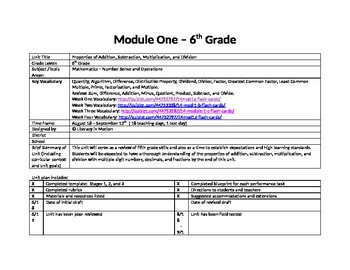Number Sense and Operations - 6th Grade Math UbD Lesson Plans
Literacy in Motion
53 Followers
Grade Levels
5th - 7th
Subjects
Resource Type
Standards
CCSS6.NS.A.1
CCSS6.NS.B.2
CCSS6.NS.B.3
CCSS6.NS.B.4
Formats Included
- Word Document File
Pages
6 pages
Literacy in Motion
53 Followers
Description
This product is a complete set of lesson plans covering all numbers sense and operations standards for 6th grade CCSS. This unit and the sample plans included are optimized for 6th grade but can easily be scaffolded for lower or higher middle level grades. Lessons are included to teach the properties of addition, subtraction, multiplication, and division.
With this file you will receive:
-Unit Plans - (editable Word file) You will receive a full six page set of lesson plans tied to the Common Core State Standards. All unit plans are in the Understanding by Design format and a cumulative performance task idea is included. We use TLI, but it is not necessary to have access to TLI in order to teach these lessons.
-Sample Lesson Idea Calendar - I have also included the lesson ideas that I use to teach this unit. Lesson plans are laid out on an 18 day calendar with 1 day of testing. All resources used to teach the standards are listed by day on the calendar. Vocabulary is included for each week, as well as homework assignments. A make-up testing day is also included in the schedule.
With this file you will receive:
-Unit Plans - (editable Word file) You will receive a full six page set of lesson plans tied to the Common Core State Standards. All unit plans are in the Understanding by Design format and a cumulative performance task idea is included. We use TLI, but it is not necessary to have access to TLI in order to teach these lessons.
-Sample Lesson Idea Calendar - I have also included the lesson ideas that I use to teach this unit. Lesson plans are laid out on an 18 day calendar with 1 day of testing. All resources used to teach the standards are listed by day on the calendar. Vocabulary is included for each week, as well as homework assignments. A make-up testing day is also included in the schedule.
Total Pages
6 pages
Answer Key
N/A
Teaching Duration
1 month
Report this resource to TPT
Reported resources will be reviewed by our team. Report this resource to let us know if this resource violates TPT’s content guidelines.
Standards
to see state-specific standards (only available in the US).
CCSS6.NS.A.1
Interpret and compute quotients of fractions, and solve word problems involving division of fractions by fractions, e.g., by using visual fraction models and equations to represent the problem. For example, create a story context for (2/3) ÷ (3/4) and use a visual fraction model to show the quotient; use the relationship between multiplication and division to explain that (2/3) ÷ (3/4) = 8/9 because 3/4 of 8/9 is 2/3. (In general, (𝘢/𝘣) ÷ (𝘤/𝘥) = 𝘢𝘥/𝘣𝘤.) How much chocolate will each person get if 3 people share 1/2 lb of chocolate equally? How many 3/4-cup servings are in 2/3 of a cup of yogurt? How wide is a rectangular strip of land with length 3/4 mi and area 1/2 square mi?
CCSS6.NS.B.2
Fluently divide multi-digit numbers using the standard algorithm.
CCSS6.NS.B.3
Fluently add, subtract, multiply, and divide multi-digit decimals using the standard algorithm for each operation.
CCSS6.NS.B.4
Find the greatest common factor of two whole numbers less than or equal to 100 and the least common multiple of two whole numbers less than or equal to 12. Use the distributive property to express a sum of two whole numbers 1–100 with a common factor as a multiple of a sum of two whole numbers with no common factor. For example, express 36 + 8 as 4 (9 + 2).


